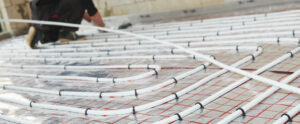How to Bleed Underfloor Heating: A Step-by-Step Guide

How to Bleed Underfloor Heating
Underfloor heating is a highly efficient way to heat your home, but like any system, it requires occasional maintenance to function optimally. One of the most important maintenance tasks is bleeding the system to ensure that air doesn’t block the flow of hot water. In this article, we will provide a complete guide on how to bleed underfloor heating, covering both technical steps and troubleshooting tips to ensure that your system runs efficiently.
Key Points:
- Recognizing when your underfloor heating needs bleeding.
- The necessary tools and materials for the process.
- A detailed, step-by-step guide on how to bleed the system.
- Troubleshooting tips for any persistent issues.
- How to maintain pressure and performance after bleeding.
If you’re having trouble with your underfloor heating system and are unsure about the next steps, don’t hesitate to contact us today to speak with one of our experts.
Expert Advice on Bleeding Underfloor Heating
Bleeding your underfloor heating system is crucial for maintaining its efficiency and performance. Whether you have a wet or electric underfloor heating system, removing air pockets from the pipes ensures that the system can operate as designed.
Let’s go over the tools and techniques required.
Tools and Materials Needed:
Before you begin, make sure you have the following items on hand:
- Screwdriver or Bleed Key: A specific tool depending on your heating system.
- Bucket or Towel: To catch any water that may escape during the process.
- Pressure Gauge: To monitor the system’s pressure, which is often integrated into the setup.
- Replacement Water: You might need to add water to the system after bleeding.
How Does Bleeding Underfloor Heating Work?
Underfloor heating systems use a network of water pipes beneath your floors to distribute heat evenly. However, air can become trapped in the pipes, leading to inefficiencies in the heating process. This can cause issues like uneven heating or even a total lack of heat in certain areas.
When to Bleed Underfloor Heating Systems:
You should consider bleeding your underfloor heating system if you notice any of the following signs:
- Strange Noises: Hissing, gurgling, or bubbling sounds from the pipes usually indicate trapped air.
- Uneven Heating: Some areas of the floor might feel warmer than others.
- Lack of Heat: If no heat is coming from the floor, it’s a clear indication that air is blocking the flow.
Common Causes of Air in Underfloor Heating Pipes:
Air can enter the system for various reasons, including:
- Installation Issues: If the system was not set up properly, air pockets can form.
- Leaks: Small leaks over time can introduce air into the pipes, disrupting the flow.
How to Bleed the Underfloor Heating System:

Here’s a step-by-step guide to ensure that you bleed your system effectively:
1. Pre-Check the System:
- Check System Pressure: Use the pressure gauge to monitor the system’s pressure. Fluctuating pressure is normal, but consistently low pressure might indicate a leak or blockage.
- Add Water if Necessary: If the pressure is too low, add water carefully to the system to bring it to the recommended level.
- Inspect Air Bleed Valves: Check the valves, typically found on the manifold, to identify where air might be trapped.
2. Bleeding the System:
- Fill and Wait: Ensure that the system is full of water and wait for about ten minutes to allow it to stabilize.
- Vent the System: Start at the lowest point of your property and work your way to the highest. Open each valve slowly to let the air escape.
- Manage Spillage: Have a towel or cloth ready to catch any water that escapes during venting.
- Drain and Reflush: After venting each valve, drain the water and flush the system to clear any debris and air.
- Repeat if Necessary: If you hear air escaping or notice uneven heating, repeat the process for each valve until the system is free from air pockets.
After Bleeding the System:

Once the bleeding process is complete, follow these final steps:
- Flush the Manifold: Connect a hose to the manifold’s top and open the drain valve at the lowest point to flush each loop of the system.
- Recheck the Pressure: After all operations are complete, check the system’s pressure again and adjust it if needed.
- Visual Inspections: Regularly inspect around valves and manifolds for leaks or loose connections.
- Monitor Water Pressure: Keep an eye on pressure levels, especially during colder months when the system operates harder.
- System Functionality: Ensure that heating is balanced across all rooms and that there are no cold spots.
- Thermostat Settings: Make sure the thermostat is set correctly. Consider upgrading to a smart thermostat for better control.
- Floor Conditions: Keep the floor surface clean to improve heat transfer.
- Energy Usage: Track your energy consumption for any unusual spikes that could indicate issues.
Do Electric Underfloor Heating Systems Need to Be Bled?
No, electric underfloor heating systems do not need bleeding because they don’t use a network of water pipes. Instead, they rely on electrical wiring or heating mats. While there is no air to remove, electric systems can still experience inefficiencies due to wiring problems or malfunctioning heating mats. If certain areas of the floor remain cold, it may indicate an issue with the system, and professional assistance may be needed.
Conclusion:
Bleeding your underfloor heating system is an essential maintenance task that helps ensure long-term efficiency. Whether it’s checking system pressure, venting air from the valves, or performing regular inspections, these steps are necessary to keep your water-based underfloor heating system functioning optimally. Electric systems, though not requiring bleeding, should still be regularly checked for electrical issues.
Maintaining your system ensures you can enjoy the benefits of underfloor heating for years to come. If you encounter any issues, don’t hesitate to reach out to an expert for help.
